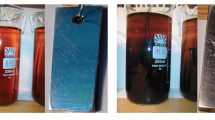Abstract
Equipment in gas and oil wells comes in contact with media, whose aggressiveness is determined by the chlorine-ion content, the partial pressure of hydrogen sulfide and carbon dioxide gas, and temperature. Hydrogen sulfide corrosion cracking (HSCC), pitting, and general corrosion are basic forms of corrosion failure in these inedia. In a number of cases, special structural steels, whose corrosion resistance can be enhanced with inhibition of the medium, are used in fabricating the equipment. Corrosion-resistant steels should be employed when inhibition is inapplicable, and, in addition to HSCC, the development of pitting and general corrosion is possible during service. The resistance of austenitic, austenitic -ferritic, and rnartensitic steels to HSCC and pitting are investigated in this paper.
Similar content being viewed by others
References
M. Barteri, L. S. Cappio, and A. Tambe, Application of corrosion-resistant OSTG to oil and gas production, Eleventh International Corrosion Congress, Florence, Italy (1990), pp. 4471–4481.
M. Celant, T. Cheldi, and D. Condanni, Material selection in hot sour deep wells, Eleventh International Corrosion Congress, Florence, Italy (1990), pp. 5501–5509.
N. Arlit, R. Grundmann, and P. Gumpel, Corrosion properties of a new high-alloy stainless steel grade containing 45 nitrogen, Eleventh International Corrosion Congress, Florence, Italy (1990), pp. 5355–5362.
M. Barteri, F. Mancia, and A. Tambe, “Microstructural study and corrosion performance of duplex and superaustenitic steel in sour well environment,” Corrosion (USA),43, No. 9, 518–528 (1987).
F. Blanchard and C. Jollian, “Tubes en aciers inoxydables pour exploitation des gisements de petrole et gaz acides solutions actuelles,” Bull. Cercle Etud. Metaux,15, No. 5–16, 23/1–23/9 (1988).
A. V. Ryabchenkov and V. M. Nikiforova, Proceedings of the Central Scientific-Research Institute of Technology and Machine Construction [in Russian], Vol. 77 (1955).
Additional information
I. P. Bardin Central Scientific-Research Institute of Ferrous Metallurgy. Translated from Metallovedenie i Termicheskaya Obrabotka Metallov, No. 7, pp. 20–25, July, 1994.
Rights and permissions
About this article
Cite this article
Fel'dgandler, É.G., Svistunova, T.V. Effect of structure and strength on the corrosion resistance of corrosion-resistant steels and alloys in media containing hydrogen sulfide and chlorine ions. Met Sci Heat Treat 36, 368–374 (1994). https://doi.org/10.1007/BF01395156
Issue Date:
DOI: https://doi.org/10.1007/BF01395156




